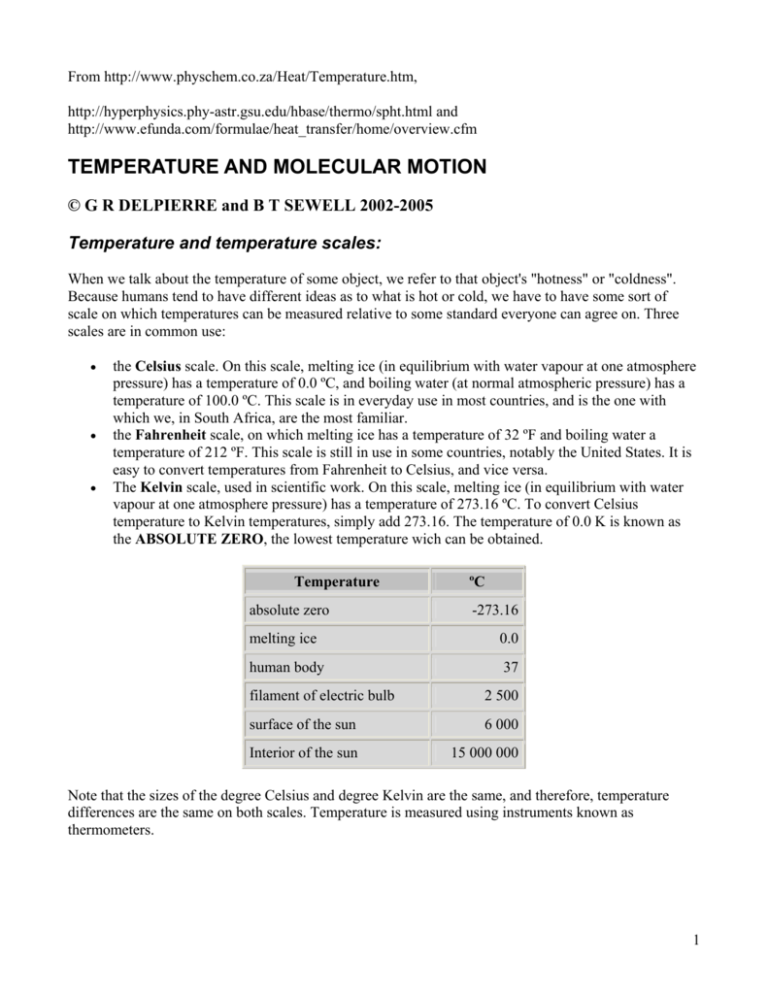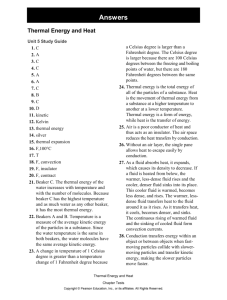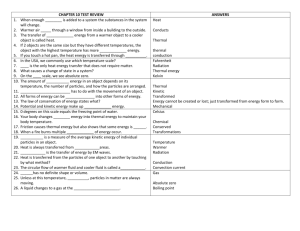PDF Format
advertisement

From http://www.physchem.co.za/Heat/Temperature.htm, http://hyperphysics.phy-astr.gsu.edu/hbase/thermo/spht.html and http://www.efunda.com/formulae/heat_transfer/home/overview.cfm TEMPERATURE AND MOLECULAR MOTION © G R DELPIERRE and B T SEWELL 2002-2005 Temperature and temperature scales: When we talk about the temperature of some object, we refer to that object's "hotness" or "coldness". Because humans tend to have different ideas as to what is hot or cold, we have to have some sort of scale on which temperatures can be measured relative to some standard everyone can agree on. Three scales are in common use: • • • the Celsius scale. On this scale, melting ice (in equilibrium with water vapour at one atmosphere pressure) has a temperature of 0.0 ºC, and boiling water (at normal atmospheric pressure) has a temperature of 100.0 ºC. This scale is in everyday use in most countries, and is the one with which we, in South Africa, are the most familiar. the Fahrenheit scale, on which melting ice has a temperature of 32 ºF and boiling water a temperature of 212 ºF. This scale is still in use in some countries, notably the United States. It is easy to convert temperatures from Fahrenheit to Celsius, and vice versa. The Kelvin scale, used in scientific work. On this scale, melting ice (in equilibrium with water vapour at one atmosphere pressure) has a temperature of 273.16 ºC. To convert Celsius temperature to Kelvin temperatures, simply add 273.16. The temperature of 0.0 K is known as the ABSOLUTE ZERO, the lowest temperature wich can be obtained. Temperature absolute zero ºC -273.16 melting ice 0.0 human body 37 filament of electric bulb 2 500 surface of the sun 6 000 Interior of the sun 15 000 000 Note that the sizes of the degree Celsius and degree Kelvin are the same, and therefore, temperature differences are the same on both scales. Temperature is measured using instruments known as thermometers. 1 Temperature and molecular motion: In order to understand the nature of heat and temperature, it is necessary to appreciate the fact that matter consists of moving particles (atoms or molecules) which can interact more or less strongly with one another. This forms the basis of the kinetic theory, which will be discussed more fully in Grade 11. The motion of the particles is increased by raising the temperature. Conversely, the motion of the particles is reduced by lowering the temperature, until, at the absolute zero (0 K), the motion of the particles ceases altogether. Because the particles are in motion, they will have kinetic energy. The particles will not all have the same energy, and the energy of the particles is constantly changing as they undergo changes in speed. Thus, for a given sample of matter, we can only talk about the average kinetic energy of the particles. Temperature is a measure of the average kinetic energy of the particles. We can look at three different phases of matter: In a solid, a metal for example, the particles are atoms, arranged in an orderly array. The atoms are relatively close to one another, and the motion of each atom is restricted by its interaction with other atoms. In a liquid, the atoms or molecules, are further apart than in a solid, and are not arranged in any special order. There is less interaction between the molecules, and they are free to move in any direction, but as interactions between the molecules are still present, most molecules are confined to the volume occupied by the liquid sample. 2 In a gas, the atoms or molecules are further apart and have little interaction with one another. The motion of these particles is confined by the walls of the containing vessels. Temperature conversions To convert from Celsius to Fahrenheit: To convert from Fahrenheit to Celsius Thermometers: A thermometer is a device used for measuring temperature. All sorts of types of thermometers exist, since any physical property which changes regularly with temperature changes (in the temperature range to be measured) can be used. Commonly, thermometers make use of the regular expansion of certain liquids such as mercury or alcohol (ethanol). 3 Kinetic energy: KINETIC ENERGY is energy which is due to motion. For example, a cricket ball of mass m, moving at a speed (strictly, velocity) v, will have a kinetic energy given by: Ek = ½mv2 The kinetic energy of a body must not be confused with POTENTIAL ENERGY, which is energy due to the location of the body. A stationary weight hanging by a string does not have any kinetic energy, as it is not moving. However, should the string break, the weight will start to move towards the surface of the earth, and will acquire kinetic energy. The stationary weight is said to have potential energy. Specific Heat by R. Nave The specific heat is the amount of heat per unit mass required to raise the temperature by one degree Celsius. The relationship between heat and temperature change is usually expressed in the form shown below where c is the specific heat. The relationship does not apply if a phase change is encountered, because the heat added or removed during a phase change does not change the temperature. The specific heat of water is 1 calorie/gram °C = 4.186 joule/gram °C which is higher than any other common substance. As a result, water plays a very important role in temperature regulation. The specific heat per gram for water is much higher than that for a metal, as described in the water-metal example. For most purposes, it is more meaningful to compare the molar specific heats of substances. The molar specific heats of most solids at room temperature and above are nearly constant, in agreement with the Law of Dulong and Petit. At lower temperatures the specific heats drop as quantum processes become significant. The low temperature behavior is described by the Einstein-Debye model of specific heat. Basics of Heat Transfer from eFunda In the simplest of terms, the discipline of heat transfer is concerned with only two things: temperature, and the flow of heat. Temperature represents the amount of thermal energy available, whereas heat flow represents the movement of thermal energy from place to place. 4 On a microscopic scale, thermal energy is related to the kinetic energy of molecules. The greater a material's temperature, the greater the thermal agitation of its constituent molecules (manifested both in linear motion and vibrational modes). It is natural for regions containing greater molecular kinetic energy to pass this energy to regions with less kinetic energy. Several material properties serve to modulate the heat tranfered between two regions at differing temperatures. Examples include thermal conductivities, specific heats, material densities, fluid velocities, fluid viscosities, surface emissivities, and more. Taken together, these properties serve to make the solution of many heat transfer problems an involved process. Heat Transfer Mechanisms Heat transfer mechanisms can be grouped into 3 broad categories: Conduction: Regions with greater molecular kinetic energy will pass their thermal energy to regions with less molecular energy through direct molecular collisions, a process known as conduction. In metals, a significant portion of the transported thermal energy is also carried by conduction-band electrons. Convection: When heat conducts into a static fluid it leads to a local volumetric expansion. As a result of gravity-induced pressure gradients, the expanded fluid parcel becomes buoyant and displaces, thereby transporting heat by fluid motion (i.e. convection) in addition to conduction. Such heat-induced fluid motion in initially static fluids is known as free convection. For cases where the fluid is already in motion, heat conducted into the fluid will be transported away chiefly by fluid convection. These cases, known as forced convection, require a pressure gradient to drive the fluid motion, as opposed to a gravity gradient to induce motion through buoyancy. Radiation: All materials radiate thermal energy in amounts determined by their temperature, where the energy is carried by photons of light in the infrared and visible portions of the electromagnetic spectrum. When temperatures are uniform, the radiative flux between objects is in equilibrium and no net thermal energy is exchanged. The balance is upset when temperatures are not uniform, and thermal energy is transported from surfaces of higher to surfaces of lower temperature. 5








